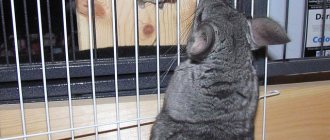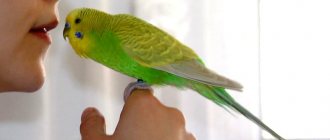After purchasing a decorative rabbit, its owners note that the pet does not want to come into their arms, runs away, hides, and sometimes even shows aggression. Few people expect such behavior, because a furry rodent is bred to give love and receive it in return. The question of how to tame a rabbit arises for everyone who has recently acquired a pet. This article will tell you why you need to accustom an animal to your hands and how to do it correctly.
Taming a rabbit
Are decorative rabbits trainable?
Rabbits are in no way inferior in their intelligence to other pets. However, a special approach must be found for all animals. Training always requires patience from the owner. An animal responds better if you show it care and affection.
In order for a rabbit to remember a command, you need to repeat it regularly. Over time, the animal will understand what is required of it and will do it without any problems. The main assistant in training is a treat. The animal must be constantly rewarded for its success in taming.
IMPORTANT! You should never shout at or hit an animal. Rabbits are very vulnerable and timid; they can hold a grudge for a long time.
For the training process to be successful, the animal and its owner must be in a good mood and training must be enjoyable for both. Training should be a game in which the rabbit is very involved.
The process of taming and training must occur gradually. Once contact has been established between the owner and the pet, you should begin learning simple exercises. The difficulty level should be increased step by step. Classes must be regular.
The first day you need to learn how to properly hold a rabbit in your hands
Sleeping at home
Each individual during its life adapts to the conditions in which its vital activity takes place. Therefore, it is possible that the pet, having settled in its place, will change its habits over time. While in a cage, a long-eared pet will most likely choose to sleep those hours when no one is home and there are no sounds that frighten it. This is why many owners do not find their pets in the arms of Morpheus. Also, rabbits often sleep with their eyes open, sitting and slightly staggering. From the outside it may seem that the animal is awake.
Over time, getting used to its place of residence and the surrounding conditions, a decorative rabbit can become much calmer. His position while falling asleep becomes more relaxed. The long-eared one sometimes falls apart on its side or dozes, lying on its back, with its paws raised up. This is a good sign. At such moments, a sleeping rabbit feels safe and completely relaxed.
How to pick up a decorative rabbit?
First of all, the new owner needs to learn how to properly pick up the animal. Animals often become very frightened when they find themselves torn off the ground, but over time the pet must get used to such sensations.
IMPORTANT! You cannot pick up a rabbit by the ears. This can cause damage to the muscles and ear membranes.
It is most convenient to pick up a pet by clasping the animal’s chest under the front legs with one hand, and supporting the body from below with the other hand. Gradually, the animal will get used to human hands and the owner can try to hold the rabbit close to him in this position. Animals often fall asleep in the arms of their owner if a trusting relationship has already developed between them.
Rules for safe transportation
- If you need to examine or transport a rabbit, do not make sudden movements. Approach him calmly. Speak kind words that calm your pet.
- While holding the animal in the canopy, try to hold it tightly to yourself so that the rabbit cannot escape and fall to the floor. Having a fragile skeleton, some pets have a very impressive weight, so such falls are fraught with various injuries.
- The lower limbs are directed away from you to avoid scratches.
There are several ways to transport safely:
- "On the hand". With one hand, support the back of the animal so that it rests on it in the area of the elbow. The forelimbs are held with the hand, preventing compression of the chest. With the other hand they hold the animal by the withers, preventing it from running away. Note: with this method, the hind legs hang freely, which allows the rabbit to relax and feel quite comfortable.
- "Head in the crook of the elbow." This carrying method is suitable for timid and cowardly animals. The rabbit's head is hidden in the crook of the elbow, and the lower part of the body is supported from below by the hand. In the shoulder area, he is supported with the other hand and pressed tightly to himself, preventing escape. For additional fixation, you can pass your hand between the hind legs, while the rabbit's legs are directed outward.
- A method suitable for carrying aggressive animals. When stressed or frightened, rabbits can become nervous and restless. Such a rabbit is taken by the withers with one hand, and supported by the back of the body with the other. The method is only suitable for short-term movements. The hind legs must be facing away from the person carrying the animal, otherwise the rabbit may injure the person with its legs when jerking.
How to tame a decorative rabbit?
Each animal has its own character traits, just like humans. Therefore, some rabbits adapt to new living conditions and to humans faster, while others require more time. The owner should not demand too much from the animal at once. The entire taming process must occur step by step.
The main stages of taming a rabbit
Initially, the animal must adapt to new living conditions. He needs to be given time to inspect the cage and all the attributes in it. It is better to start contacting the animal after it has looked around, eaten and washed itself in its new house.
The first step is to talk to the animal at close range. You need to talk quietly and calmly so that the pet does not get scared . If the animal behaves restlessly and hides, further acquaintance should be postponed until later. If the rabbit is not afraid and behaves calmly, you can proceed to further actions.
IMPORTANT! When in contact with an animal, you should not use cosmetics and perfumes with a strong odor, as this may scare the pet away.
The next step will be to introduce the rabbit to the hands of the owner. The pet must realize that human hands do not pose any danger to it. To do this you need:
- carefully bring a clean hand into the animal’s cage;
- attract the animal's attention;
- give the rabbit the opportunity to hug your hand, lick it, maybe bite it lightly.
IMPORTANT! To inspire trust in the animal, you can put a treat (for example, a piece of fruit) in your hand. Hand feeding is the best way to build rapport with your animal.
If the animal reacts adequately to your hands and treats itself to treats without fear, you can try touching it and petting it a little.
After taming, you can let the rabbit out for a walk
When the rabbit is already well accustomed to being handled and behaves calmly, the animal can be released for a walk. To do this you need:
- Place the cage on the floor and open the door. The animal will immediately become interested in an open exit and will rush out of the cage.
- At this time, the owner should also sit on the floor and watch the pet without moving. As a rule, the rabbit begins to explore its owner with interest.
- If the animal makes contact, it needs to be treated with a treat to build trust.
Gradually, the animal will get used to such walks and will allow itself to be petted outside the cage. You can train the animal to climb onto your hand on its own by placing a treat in your open palm. The animal, in pursuit of a tasty morsel, will itself climb onto your hand. The owner will need to gradually lift his hand off the ground, increasing the height, while stroking the animal with his second hand.
IMPORTANT! If during any stage of taming the rabbit curls up into a ball, this indicates that the animal is very scared. In this case, the animal should be left alone and given time to recover.
Timing of taming
You should not expect that the rabbit will willingly make contact on the first day, allow itself to be stroked and held in your arms. This can happen after a few days, or maybe after a few weeks or months. The duration of the process depends on the individual characteristics of the pet itself, as well as on the owner’s approach to training.
Peculiarities
By nature, rabbits are very timid animals, and with good reason. In their natural habitat, they often become prey for predators or hunters. Therefore, they have to be on alert almost around the clock. The unusual sleep patterns of animals are associated with these features. Rabbits are most active in the early morning hours and evening twilight.
By the way, most breeds are perfectly oriented in the dark. Predatory animals, as a rule, do not hunt at this time, and the long-eared cowards go in search of food. At the same time, they move a lot and actively, losing a large amount of strength and energy. Therefore, they simply need sleep and rest.
But they simply cannot relax and fall into a peaceful sleep for a long time in natural conditions. Therefore, rabbits have developed their own resting mechanisms.
Why does a rabbit show aggression?
Rabbits are not aggressive animals; as a rule, they are affectionate and friendly, but some individuals can show aggression: biting hands while feeding, attacking legs while walking and trying to bite them. Such behavior patterns will not bring any pleasure to the owner, so the animal’s actions should be corrected.
Most often, signs of aggression are observed in animals with the highest intellectual abilities. With proper upbringing, such rabbits are highly trainable and successfully carry out the owner’s commands.
When working on a pet's behavior, the owner should remember the following:
- Aggressive behavior in rabbits is not natural; most often such manifestations occur under the influence of external factors;
- rabbit aggression is not a manifestation of some kind of negative attitude towards the owner, such behavior provokes the fear suffered by the animal;
- You cannot respond to your pet’s aggressive behavior with the same aggression, this will only aggravate the situation and create even more problems in communicating with the animal.
IMPORTANT! Fear is not only the reason for a rabbit’s aggressive behavior, but in some situations, fear can lead to the death of the animal.
Rabbits don't act aggressively without a reason.
Causes
Rabbits will not show aggression towards their owner without a reason. Most often, this behavior of the animal is associated with the following circumstances:
- the lack of affection from the owner, a hostile attitude towards the animal and its fear require the rabbit to show protection, which becomes the cause of aggressive behavior;
- when the rabbit reaches puberty, periods of excitement in the animal are associated with circular movements at the owner’s feet, biting and jumping;
- changes in the hormonal state of pregnant rabbits may be accompanied by aggressive behavior;
- a female with small rabbits can be aggressive towards humans, thus protecting her offspring.
How to stop biting?
There is no single way to stop a rabbit from biting. Everything will depend on the reason for the animal’s behavior. If the animal has reached sexual maturity, you can get rid of its biting in an excited state in two ways:
- find a suitable mate for the animal;
- sterilize the animal.
If we are talking about a pregnant female or a female with rabbits, then it is better to leave the animal alone for a while, since her aggression is natural and this period can only be waited out.
If the animal is aggressive due to the rude attitude of the previous owner towards it, then in this case you will have to spend time re-educating it. The main task is to instill trust in the animal and relieve it of fear.
IMPORTANT! You can protect yourself from rabbit bites during the period of re-education by wearing closed clothing; you should also not allow the animal to roam freely throughout the apartment so that it does not harm other family members and the surrounding area.
If the rabbit is overly aggressive, you can calm the pet a little by lightly pressing it to the floor. This way he will feel that there is a dominant person in front of him, to whom he must obey.
Gradually, the animal should be accustomed to contact with hands. It is better to encourage the taming process with treats so that the animal develops positive associations. The rabbit must understand that contact with a person does not cause any harm to it.
Sometimes pets bite their owner while feeding. There is a simple explanation for this. Rabbits have difficulty seeing objects at close range, and the pleasant smell of food coming from their hands attracts them. You can solve the problem by simply stopping giving food with your hands. Food can be placed into the cage using a spoon.
If the rabbit is frightened by some sudden movement or noise, the animal needs to be calmed down. To instill more trust in your pet, you can knead the rabbit’s bedding with your hands so that it has a familiar smell to it, and only after that pet or pick up the animal.
Factors influencing the domestication process
The success of taming a rabbit directly depends on the following factors:
- Heredity (genotype). When purchasing a long-eared rodent from a breeder or in a specialized nursery, it is worth looking at the animal’s mom and dad and observing their behavior. The pet can inherit from them such temperamental traits as friendliness or aggressiveness. It will be much easier to accustom a rabbit to being handled if its parents are affectionate and tame enough.
- Age. If possible, it is better to adopt a small rabbit, as it can be tamed much easier and faster. Sometimes a child is not very affectionate, but as he grows up he becomes more gentle. Having become attached to the owner, he becomes contactable - he goes into his arms, is caressed and willingly plays.
- Health. A sick rabbit does not feel well, so it is not very willing to approach. He is afraid and tries to hide, hide in a corner. If you suspect something is wrong, you should carefully examine your pet. The coat should be smooth, clean, and free of tangles. Ears and eyes without visible inflammation or discharge.
What breeds are worth training?
The following breeds are considered especially trainable eared species:
- Flanders
- Dutch
- Angora
- Fox
- Lion head
- Angora lion
- Lop-eared rabbit ram
- Decorative hare
- Ognevka
- Dwarf rex
- Hermelin
- Dwarf butterfly
- Squirrel.











